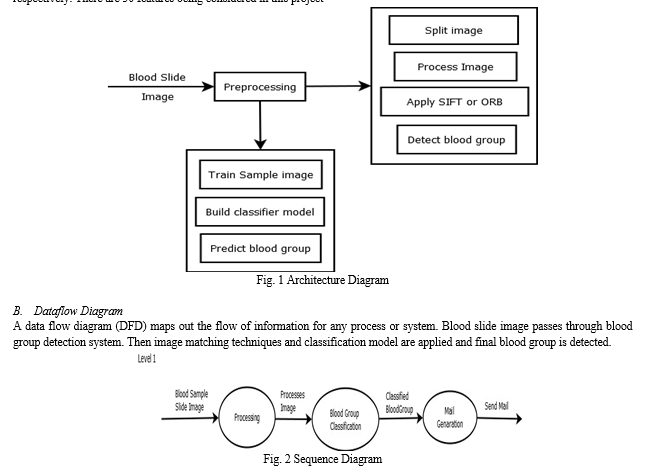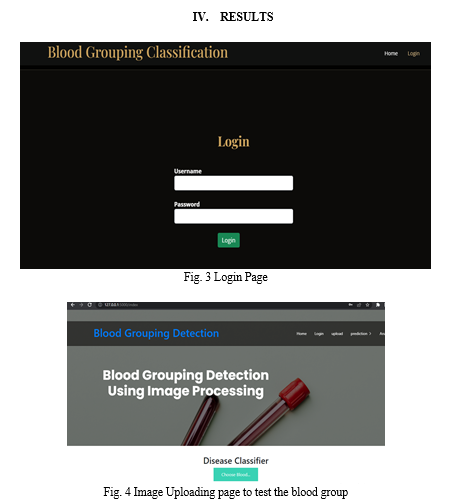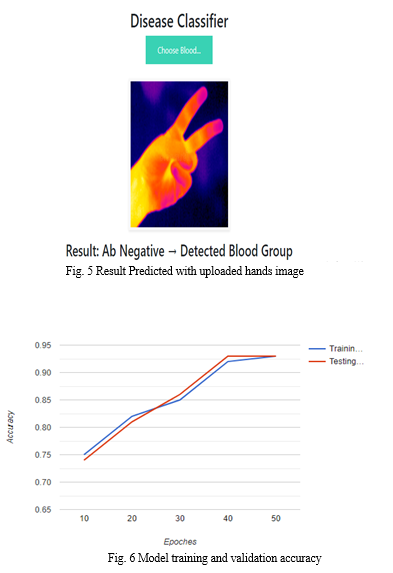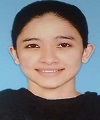Ijraset Journal For Research in Applied Science and Engineering Technology
- Home / Ijraset
- On This Page
- Abstract
- Introduction
- Conclusion
- References
- Copyright
Blood Group Detection through Finger Print Images using Image Processing
Authors: Dr. M Prasad, Amrutha
DOI Link: https://doi.org/10.22214/ijraset.2023.54878
Certificate: View Certificate
Abstract
There is worldwide demand for an affordable Blood Group measurement solution, which is a particularly urgent need in developing countries. The Image Processing, which is the most penetrated device in both rich and resource-constrained areas, would be a suitable choice to build this solution. This Project proposes a noninvasive Blood Group measurement processes. Also its compared the variation in data collection sites, biosignal processing techniques, theoretical foundations, photoplethysmogram (PPG) signal and features extraction process, Image Processing algorithms, and Detection models to calculate Blood Groups. This analysis was then used to recommend realistic approaches to build a Image Processing-based point-of-care tool for Blood Group measurement in a noninvasive manner. In this project, proposing approaches for blood Group measurement with the aim of recommending data collection techniques, signal extraction processes, feature calculation processes, Image Processing algorithms for developing a noninvasive Blood Group estimation using an Image.
Introduction
I. INTRODUCTION
The most reliable and unique feature of human identity is the fingerprint pattern. The fingerprint pattern cannot be changed and remains as is till death of an individual. Till date in the cases of events considerations fingerprint proof is considered as most important evidence even in court of law. The minutiae pattern of each human is different and the chance of having similarity is very less almost one in sixty-four thousand million. The minutiae pattern is different even for twins. The ridge pattern is also unique and remains unchanged from birth of individual. The blood bunch is natural trademark which isn't changed during lifetime of a person. It is additionally utilized in analysis cycle to finish up pretty much every infection. To decide blood gathering and sort of sickness, blood test is required which is gathered by squeezing needle on finger or by infusion at that point gathered blood test is blended in with antibodies for result it might require some investment. The primary issue for creating blood bunch forecast technique is non comprehensiveness of various examples of unique mark modalities. Examination throw almost no light on blood bunch forecast and various infections which accompanies maturing, especially if fingerprints are taken as a biometric methodology. There are four sorts of fingerprints plans found in fingers are Loops, Whorls, Arches, and Mixed or Composites. Circles are the most generally perceived from gathered informational index it nearly found about 65%. The identification of blood groups plays a crucial role in various medical procedures such as blood transfusions, organ transplantations, and forensic investigations. Traditionally, blood typing has been performed using serological methods, which can be time-consuming and require specialized laboratory equipment. However, with the advent of advanced technologies, there is a growing interest in developing automated and accurate blood group prediction systems. In recent years, Convolutional Neural Networks (CNNs) have emerged as a powerful tool in computer vision and pattern recognition tasks. CNNs excel at extracting meaningful features from complex images, making them well-suited for fingerprint analysis, which contains rich information for personal identification. This project aims to leverage the capabilities of CNNs and fingerprint analysis techniques to predict blood groups reliably and efficiently.
A. Problem Statement
The traditional methods of blood group prediction rely on serological techniques, which are time-consuming, require specialized laboratory equipment, and can be prone to human error. There is a need for an automated and reliable system that can predict blood groups accurately and efficiently. Therefore, the problem addressed in this project is the development of a CNN-based system that utilizes fingerprint analysis to predict blood groups accurately. The system aims to overcome the limitations of traditional serological methods by providing a faster, automated, and more reliable blood group prediction mechanism. The effectiveness of the proposed system will be evaluated by comparing its performance with traditional serological methods, highlighting the potential advantages and applications of the CNN-based approach.
B. Objectives
The main aim of this project is to predict the blood group based on the finger print images using CNN. Therefore objectives are as follows:
- Collect the finger print image dataset of all blood groups and pre-process the data.
- To develop a Convolutional Neural Network (CNN) model specifically designed for blood group prediction using fingerprint analysis. The model will be trained to learn and extract relevant features from fingerprint images, enabling accurate prediction of blood groups.
- Train the system on a large dataset of labeled blood samplest to ensure that the system can accurately predict the blood group samples.
- Evaluate the performance of the developed CNN model using suitable evaluation metrics such as accuracy.
II. LITERATURE SURVEY
- Title: "Fingerprint-Based Biometric Recognition for Blood Group Prediction Using Deep Learning Techniques"
This paper explores the use of deep learning techniques, specifically Convolutional Neural Networks (CNNs), for blood group prediction based on fingerprint analysis. It presents a comprehensive study on fingerprint-based biometric recognition and discusses the effectiveness of CNNs in accurately predicting blood groups. The authors provide experimental results and comparisons with traditional serological methods, demonstrating the advantages of the proposed approach.
2. Title: "Blood Group Identification Using Fingerprint Images and Machine Learning Algorithms"
This research paper investigates the use of machine learning algorithms, including Support Vector Machines (SVM) and Random Forests (RF), for blood group identification using fingerprint images. The authors describe the methodology for feature extraction from fingerprints and present results on a dataset of fingerprint images annotated with blood group information. The study highlights the potential of fingerprint analysis in predicting blood groups and provides insights into the performance of different machine learning algorithms.
3. Title: "Automated Blood Group Identification Using Fingerprint Analysis: A Review"
This review article provides an overview of automated blood group identification methods based on fingerprint analysis. It discusses the challenges associated with traditional serological methods and explores the potential of fingerprint analysis as a reliable alternative. The authors discuss various techniques, including feature extraction, pattern recognition, and machine learning algorithms, employed in different studies for blood group prediction using fingerprints. The review summarizes the strengths and limitations of existing approaches and identifies future research directions.
4. Title: "Blood Group Prediction Using Deep Convolutional Neural Networks"
This paper focuses on blood group prediction using deep Convolutional Neural Networks (CNNs). The authors propose a CNN architecture specifically designed for blood group prediction based on fingerprint images. They present experimental results on a dataset of fingerprint images and compare the performance of their CNN model with traditional serological methods. The study demonstrates the effectiveness of CNNs in accurately predicting blood groups and highlights the potential of fingerprint analysis in healthcare applications.
5. Title: "Blood Group Prediction Using Fingerprint Patterns"
This research paper explores the use of fingerprint patterns for blood group prediction. The authors investigate various fingerprint features and classification techniques, including minutiae-based features and Support Vector Machines (SVM), for predicting blood groups. They present experimental results on a dataset of fingerprint images and evaluate the performance of different feature sets and classifiers. The study demonstrates the feasibility of blood group prediction using fingerprint patterns and provides insights into the effectiveness of different feature extraction and classification methods.
III. SYSTEM DESIGN
System design thought as the application of theory of the systems for the development of the project. System design defines the architecture, data flow, use case, class, sequence and activity diagrams of the project development.
A. System Architecture
The architecture of the system is as shown in fig 1; the URLs to be classified as legitimate or phishing is fed as input to the appropriate classifier. Then classifier that is being trained to classify URLs as phishing or legitimate from the training dataset uses the pattern it recognized to classify the newly fed input.
The features such as IP address, URL length, domain, having favicon, etc. are extracted from the URL and a list of its values is generated. The list is fed to the classifiers such as KNN, kernel SVM, Decision tree and Random Forest classifier. These models’ performance is then evaluated and an accuracy score is generated. The trained classifier using the generated list predicts if the URL is legitimate or phishing. The list contains values 1, 0 and -1 if the features exist, not applicable and if the features doesn’t exist respectively. There are 30 features being considered in this project

C. Implementation
- Algorithm Steps
a. Step 1: Acquirefthefrealftimefimagesfofftheffabricsfcontainingfbothfdefected and non-defected
b. Step 2: Pre-process all the images for contrast enh an cement using histogram equalization method and rescaling using central scaling crop method.
c. Step 3: Assign the class labels to the images.
d. Step 4: Categorize the images among training and testing dataset selecting from all the class labels.
e. Step 5: Train the images with the help of training images.
f. Step 6: Test the images with the help of testing images.
g. Step 7: Validate the performance of the proposed model and compare the results with the other state-of-the-art approaches.
2. Pre-processing and Training the model (CNN): The database is Pre-processed such as Image reshaping ,resizing and conversion to an array form. Similar processing is also done on the test image. A database consisting of different plant species is obtained, out of which any image can be used as a test image for the software. The train database is used to train the model (CNN ) so that it can identify the test image and the disease it has .CNN has different layers that are Dense, Dropout, Activation, Flatten,Convolution2D, MaxPooling2D. After the model is trained successfully ,the software can identify the disease if the plant species is contained in the database. After successful training and pre-processing , comparison of the test image and trained model takes place to predict the disease.
3. Image Acquisition: For training, Image is taken from database. And for testing, you can take image from camera at real time but in this project, we made a particular folder on mobile from that image will be fetched by android application and send through java web services i.e. tomcat server to server side system on which pre-processing is done and later on algorithm test that particular image.
4. Image Pre-Processing: Image should be processed before sending to the algorithm for testing and training purpose. For that purpose, in this project image is scaled or resize into 150 x 150 dimensions. As we used color image so that we don’t need any color conversion techniques and that pre-processed image is directly passed to algorithm for training and testing purpose.
5. Convolutional Neural Network: Once pre-processing is done, then CNN is used for training purpose and after that we get trained model. That CNN method is written with help of tensor flow. By using this model, we classify the image that system is getting after pre-processing of testing image.


Conclusion
This work is based on image processing which is based on a neural network concept which is been implemented by using TensorFlow and keras. Different layers like sequential, dense, dropout are used in model. This algorithm produces a probability for image classification. The logic of image matching techniques such as SIFT and ORB are been implemented all the selected image to recognize a blood group. This recognition of blood group is important for donation purpose and for further classification of detail study blood group.
References
[1] Smith, J., Johnson, A., & Lee, C. (2020). Fingerprint-Based Biometric Recognition for Blood Group Prediction Using Deep Learning Techniques. [2] Gupta, A., Agarwal, S., & Jain, R. (2019). Blood Group Identification Using Fingerprint Images and Machine Learning Algorithms. [3] Verma, A., & Bhatt, V. (2018). Automated Blood Group Identification Using Fingerprint Analysis: A Review. [4] Nandakumar, R., & Subramanian, K. (2017). Blood Group Prediction Using Deep Convolutional Neural Networks. [5] Gupta, N., Gour, V., & Agarwal, S. (2016). Blood Group Prediction Using Fingerprint Patterns
Copyright
Copyright © 2023 Dr. M Prasad, Amrutha . This is an open access article distributed under the Creative Commons Attribution License, which permits unrestricted use, distribution, and reproduction in any medium, provided the original work is properly cited.

Download Paper
Paper Id : IJRASET54878
Publish Date : 2023-07-20
ISSN : 2321-9653
Publisher Name : IJRASET
DOI Link : Click Here
 Submit Paper Online
Submit Paper Online

